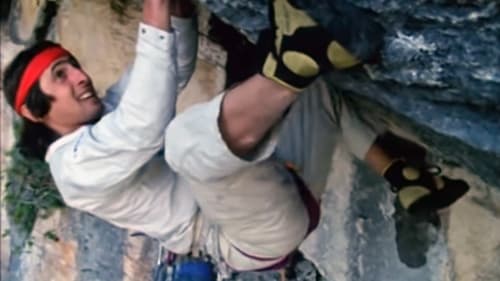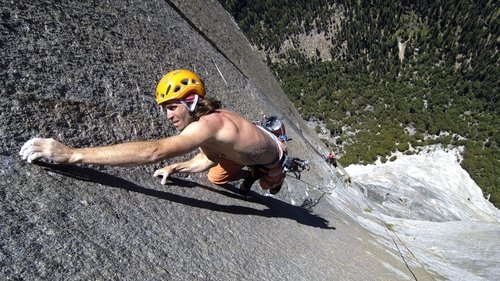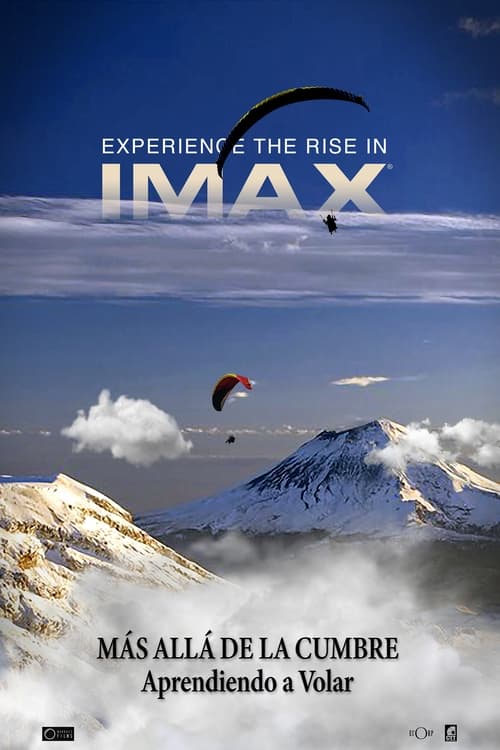Found 20 movies, 2 TV shows, and 0 people
Can't find what you're looking for?

No description available for this movie.

No description available for this movie.

Paragot and Bérardini: two climbers who fill all climbing enthusiasts with admiration. In Fontainebleau, Saussois, the Alps, the Andes, the Himalayas, and all over the world, they have left their names attached to the most difficult routes and the most prestigious peaks. Here, they recount only the climbs they completed together: famous expeditions to Aconcagua and Huascarán, firsts in the Alps and the Dolomites. An unwavering friendship, comical and tragic adventures—this is what they share with us in the warm atmosphere of their memories. "La Cordée des Voyous" will be included in Jean Afanassieff's film "La Grande Cordée," which deals with post-war proletarian mountaineering.

At the Limit is a documentary about extreme climbing. In this sports documentary, Pepe Danquart shows brothers Thomas and Alexander Huber climbing in Patagonia and on the granite rock "El Capitan" in Yosemite Valley (USA). A key part of the film is their attempt at a speed ascent of the 1,000-meter-high route "The Nose," in which the two athletes aim to break the then speed record of 2:48:30 hours, set by Hans Florine and Yuji Hirayama in September 2002.

La Dura Dura is a documentary about climbing in Oliana and Margalef. Directed by Josh Lowell in 2012 and produced by Sender Films, it is part of the Reel Rock 7 series. Chris Sharma has dominated the climbing world for 15 years, but a 19-year-old prodigy, Adam Ondra, is now hot on his heels. The legend and the young outsider team up in Spain to open the world's most perilous climbing route.

Joseph Vallot and his team of guides and porters climb Mont Blanc in 1906. Their ascent will take three days. They spent their nights at the Grands Mulets refuge and the Grand Plateau refuge. This is the very first successfully filmed ascent. Joseph Vallot (1854-1925), rich heir of Lodève in Occitania. He devotes part of his fortune to the observation of the Alps, sometimes opposing the scientific community. He built an observatory, still standing today.

Many mountaineers as part of their activity have used cameras and films to allow us to participate through images in their adventures and their emotions. Many of them have become true film professionals: Joseph Vallot, Lionel Terray, Marcel Ichac, Renè Vernadet, Jean Afanasieff, Pierre Royer, Denis Ducroz, Kurt Diemberg and many others are among the conquerors of the image of the mountain. The film depicts the passion of these men on the highest mountains in the world... behind the lens.

The film shows Catherine Destivelle's trip to Dogon Country, in Mali, where she will make spectacular free solo rock climbing ascents in the sun-warmed cliffs of Bandiagara. Destivelle is accompanied on this trip by a friend climber, Lucien Abbet. A film by Pierre-Antoine Hiroz produced in 1987 by Paradoxe and also featuring Tidjani Koné, Ibrahim Dolo, and the Dogon inhabitants of the Bandiagara Escarpment. The film won the Genziana D'argento for best free climbing film at the Trento Film Festival in 1987.

The Tyrolean David Lama has climbed an 8a route already at the age of ten, and he has become several times Youth World Champion and European Youth Champion in bouldering and lead climbing. In 2010, at the age of 20 years, David decided to leave the indoor climbing and competition world behind him. Since then, he is focusing on Alpinism, the most difficult routes and first ascents in the Alps, but as well in India and America. This documentary portrays David Lama from his first climbing attempts as a little boy to his big adventures in present time. We see famous locations, such as the climbing paradise on Lake Garda, the notorious Sagwand Face in the Zillertal Alps, and the 7.821m high Masherbrum in the Karakorum with its still untouched north east face.

In the shady campgrounds of Yosemite valley, climbers carved out a counterculture lifestyle of dumpster-diving and wild parties that clashed with the conservative values of the National Park Service. And up on the walls, generation after generation has pushed the limits of climbing, vying amongst each other for supremacy on Yosemite's cliffs. "Valley Uprising" is the riveting, unforgettable tale of this bold rock climbing tradition in Yosemite National Park: half a century of struggle against the laws of gravity -- and the laws of the land.

Ueli Steck (Switzerland), Simone Moro (Italy) and Jon Griffith (GB) are not like 95% of the climbers on Everest: they don't use oxygen, altimeters (improperly called Sherpas), or fixed ropes. In 2013, the trio aims to repeat the arduous Western Spur. The Sherpas have the mission to equip the mountain with fixed ropes on this famous day, up to Camp 3: ropes without which customers of commercial expeditions could not climb Everest. An argument ensued, insults were hurled from both sides. The confrontation at Camp 2 degenerated: a Sherpa water bottle physically attacked the trio of Europeans. Blows and stones were thrown and threats led the trio to flee the mountain. The Réel Rock film crew, which is part of the climbing team, films this chaos without complacency.

No description available for this movie.

In 1983, the French Mountain Federation (FFM) organized a landmark climbing gathering in Saussois and the Verdon, bringing together generations of the greatest climbers of the time, including Patrick Edlinger, Jean-Claude Droyer, Jerry Moffatt, Jean-Claude Droyer, Robert Paragot, Lucien Bérardini, Ron Fawcett, Jean-Pierre Bouvier, and other major figures. This event symbolized the emergence of modern sport climbing as a practice in its own right in France, with the liberation of legendary routes and the rise of freestyle climbing, notably under the leadership of Droyer and Edlinger. This gathering was a key moment in the dissemination of the freestyle ethic and the evolution of grading, while Saussois and the Verdon were at the forefront of high difficulty in the world.

This documentary is a reconstruction, based on archive footage, testimonies, and filmed reconstructions, of the Vincendon / Henry tragedy. December 1956: Jean Vincendon and François Henry, two young mountaineers, aspire to join the High Mountain Group. Lacking experience, they set out to climb Mont Blanc via the Brenva spur in the middle of winter. The weather conditions deteriorated, and they decided to give up before meeting Walter Bonatti and Sylvano Gheser. They then decided to continue the climb and set off in two different roped parties. Bonatti decided to take refuge at the Vallot refuge higher up, rather than descend. The two young mountaineers, overcome by the poor weather conditions and fatigue, remained stuck for several days at 4,000 meters. What followed was a completely disorganized rescue operation that became, for more than ten days, a spectacle for all of France and a national tragedy.

In the high peaks of Afghanistan, young athletes from rival villages build makeshift wooden skis and convene for a mountain race that unites the community in a moment of peace and triumph just before their country’s collapse. Champions of the Golden Valley merges the triumphant spirit of a classic underdog sports story with the heartfelt portrait of a community finding hope amid disrupted dreams. Revealing a stunning unseen side of Afghanistan, it is an uplifting exploration of what it means to be a champion – in all its forms.

At the peak of her career as a rock climber, Catherine Destivelle goes to the United States to get away from the competitions and to recharge batteries. There, Destivelle travels by car through Utah and Wyoming to make spectacular free solo ascents in Indian Creek, where she soloes 'Supercrack' (5.10d), in Dead Horse Point State Park, and on the iconic Devil's Tower, where she climbs unroped the second half of the classic 130-foot route 'El Matador' (5.10d).

Mont Blanc, the highest peak in the Alps, rises to 4,810 m and was first climbed on August 8, 1786. Chamonix natives Jacques Balmat and Michel Paccard set out on the afternoon of August 7 and returned victorious on the morning of the 9th, after two nights spent outdoors. This film is a staging that reconstructs this great event with all the problems it created and resolved, thus contributing to the emergence of the modern concept of mountaineering. Denis Ducroz, guide and filmmaker, immerses us in the minds and times of these two men, 224 years later.

In some of the most extraordinary natural landscapes in Mexico, a group of mountaineers have set out to explore a world labeled as impossible, but from a space reserved only for birds.

At once a high-level musician, member of the October Group, entertainer, theater artist, film actor, mountaineer, and skier, Maurice Baquet, always on the move, structured his life around two common threads: the cello and the mountains. He once defined himself as a "cellist-skier," "all alone" in this category, which prompted James Couttet, world ski champion, to say: "Of all the skiers I know, he's the best cellist." Echoing this, Professor at the Conservatoire National Supérieur, André Navarra, added: "Of all the cellists I know, he's the best skier." Throughout his varied yet coherent career, Baquet helped to project a joyful and artistic image of the mountains. Who better to talk about Maurice and all his adventures than his alter-ego: Cérébos, the faithful cello that never left his side? From Paris to Chamonix, from the stage to the granite slabs and snowy slopes, this film follows Cérébos, crossing the century and above all... smiling!

The most important mountain range in Europe is more than a holiday destination for sports and relaxation. The Alps are not just an unpredictable force of nature against which humans have to assert themselves again and again, or an area steeped in history, but also a landscape that enchants. The documentary takes a foray through the history and geography of the Alps.